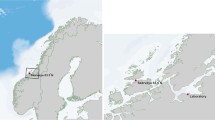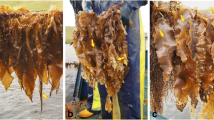Abstract
Little is known about offshore cultivation of the edible seaweed Undaria pinnatifida outside Asian waters. However, currently its commercial cultivation is being considered in the North Western Atlantic coast of Spain (Galicia). The effect of outplanting time and methodologies related to the cultivation of U. pinnatifida in this area was studied. Biomass yield, morphological features, and growth rate were examined on sporophytes outplanted from October to December at the same site in a coastal bay. Experiments were conducted over two years, applying different harvesting and cultivation methods. Results indicate that the most suitable months for outplanting were October and November, with larger biomass production as well as improved sporophyte quality (i.e., morphology). Cultivations from October to December ended when most of the sporophytes had developed sporophylls (reproductive structures) and this occurred between early and late April in all the outplanting trials. The similar harvest time for all plants suggests that harvesting time is not related to outplanting period but should be mainly influenced by the photoperiod. These results suggest a single harvest as the most appropriate method. Moreover, results also showed that cultivation was successful using the two tested methods: seedling string all along the culture rope and seedling strings inserted at regular intervals into the rope. Finally, this paper also discusses the suitability of two different systems of offshore farming: in long-line and in vertical rope.





Similar content being viewed by others
References
Akiyama K, Kurogi M (1982) Cultivation of Undaria pinnatifida (Harvey) Suringar, the decrease in crops from natural plants following crops increase from cultivation. Bull Tohoku Reg Fish Res Lab 44:91–100
Báez JC, Olivero J, Peteiro C, Ferri-Yánez F, García-Soto C, Real R (2010) Macro-environmental modelling of the current distribution of Undaria pinnatifida (Laminariales, Ochrophyta) in northern Iberia. Biol Invasions 12:2131–2139
Casas G, Piriz ML, Parodi ER (2008) Population features of the invasive kelp Undaria pinnatifida (Phaeophyceae: Laminariales) in Nuevo Gulf (Patagonia, Argentina). J Mar Biol Assoc UK 88(1):21–28
Castric-Fey A, Beaupoil C, Bouchain J, Pradier E, L’Hardy-Halos MT (1999a) The introduced alga Undaria pinnatifida (Laminariales, Alariaceae) in the rocky shore ecosystem of the St. Malo area: morphology and growth of the sporophyte. Bot Mar 42:71–83
Castric-Fey A, Beaupoil C, Bouchain J, Pradier E, L’Hardy-Halos MT (1999b) The introduced alga Undaria pinnatifida (Laminariales, Alariaceae) in the rocky shore ecosystem of the St. Malo area: growth rate and longevity of the sporophyte. Bot Mar 42:83–96
Choi HG, Kim YS, Lee SJ, Nam KW (2007) Growth and reproductive patterns of Undaria pinnatifida sporophytes in a cultivation farm in Busan, Korea. J Appl Phycol 19:131–138
Choi CG, Oh SJ, Kang IJ (2009) Growth and morphological characteristics of Undaria pinnatifida in the cultivation ground at Busan, Korea. J Fac Agr, Kyushu Univ 54(1):47–51
Creed JC, Kain (Jones) JM, Norton TA (1998) An experimental evaluation of the density and plant size in two large brown seaweeds. J Phycol 34:39–52
Cremades J, Salinas JM, Granja A, Bárbara I, Veiga AJ, Pérez-Cirera JL, Fuertes C (1997) Factores que influyen en la viabilidad y crecimiento de Undaria pinnatifida en cultivo: fouling, tamaño de plántula y períodos de aclimatación presiembra. NACC Biol 7:29–40 (in Spanish with English abstract)
Cremades J, Freire Ó, Peteiro C (2006) Biología, distribución e integración del alga alóctona Undaria pinnatifida (Laminariales, Phaeophyta) en las comunidades bentónicas de las costas de Galicia (NW de la Península Ibérica). Anales Jard Bot Madrid 63(2):169–187 (in Spanish with English abstract)
Hay CH, Villouta E (1993) Seasonality of the adventive Asian kelp Undaria pinnatifida in New Zealand. Bot Mar 36:461–476
Hunt R (1982) Plant growth curves. Edward Arnold, London
Hurd CL (2000) Water motion, marine macroalgal physiology and production. J Phycol 36:453–472
ICES (2007) Alien species alert: Undaria pinnatifida (wakame or Japanese kelp). ICES Coop Res Rep No 283:1–36
Lüning K (1993) Environmental and control of seasonal growth in seaweeds. Hydrobiologia 260/261:1–14
Mariño J, Campos MJ, Nunes MT, Iglesias MT (1985) Variación estacional de los factores ambientales y del fitoplancton en la zona de Lorbé (Ría de Ares y Betanzos) en 1978. Bol Inst Esp Oceanogr 2(1):88–99 (in Spanish with English abstract)
Nanba N, Fujiwara T, Kuwano K, Ishikawa Y, Ogawa H, Kado R (2009) Effect of pre-incubation irradiance on survival of cryopreserved gametophytes of Undaria pinnatifida (Phaeophyta) and morphology of sporophytes formed from the gametophytes. Aquat Bot 90:101–104
Neushul M, Benson J, Harger BWW, Charters AC (1992) Macroalgal farming in the sea: water motion and nitrate uptake. J Appl Phycol 4:255–265
Oh SH, Koh CH (1996) Growth and photosynthesis of Undaria pinnatifida (Laminariales, Phaeophyta) on a cultivation ground in Korea. Bot Mar 39:389–393
Ohno M, Matsuoka M (1993) Undaria cultivation “wakame”. In: Ohno M, Critchley AT (eds) Seaweed cultivation and marine ranching. Japan International Cooperation Agency (JICA), Jokosuka, pp 41–49
Pang S, Lüning K (2004) Photoperiodic long-day control of sporophyll and hair formation in the brown alga Undaria pinnatifida. J Appl Phycol 16:83–92
Perez R, Kass R, Barbaroux O (1984) Culture expérimentale de l'algue Undaria pinnatifida sur les côtes de France. Sci Pêche (343):3–15 (in French with English abstract)
Perez R, Kaas R, Campello F, Arbault S, Barbaroux O (1992) La culture de l’algue Undaria pinnatifida (Harvey) Suringar. In: La culture des algues marines dans le monde. Service de la Documentation et des Publications (SDP), IFREMER, Plouzane; France, pp 425–462 (in French)
Pérez-Cirera JL, Salinas JM, Cremades J, Bárbara I, Granja A, Veiga AJ, Fuertes C (1997) Cultivo de Undaria pinnatifida (Laminariales, Phaeophyta) en Galicia. NACC Biol 7:3–28 (in Spanish with English abstract)
Pérez-Villar V, Gómez-Gesteira M, Pérez-Muñuzuri V (2000) Modelización informática. In: Ordenación integral del espacio marítimo-terrestre de Galicia. Fundación Empresa-Universidad Galega, Santiago de Compostela, pp 41–46 (in Spanish)
Peteiro C (2001) Cultivo experimental con fines industriales de Undaria pinnatifida (Laminariales, Phaeophyta) en la Ría de Ares y Betanzos (A Coruña). Unpublished degree dissertation, University of A Coruña, A Coruña, Spain (in Spanish)
Peteiro C, Freire Ó (2011) Effect of water motion on the cultivation of the commercial seaweed Undaria pinnatifida in a coastal bay of Galicia, Northwest Spain. Aquaculture 314:269–276
Primo C, Hewitt CL, Campbell ML (2010) Reproductive phenology of the introduced kelp Undaria pinnatifida (Phaeophyceae, Laminariales) in Port Phillip Bay (Victoria, Australia). Biol Invasions 12:3081–3092
Reed DC (1990) An experimental evaluation of density dependence in a subtidal algal population. Ecology 71:2286–2296
Russell LK, Hepburn CD, Hurd CL, Stuart MD (2008) The expanding range of Undaria pinnatifida in southern New Zealand: distribution, dispersal mechanisms and the invasion of wave exposed environments. Biol Invasions 10:103–115
Sahoo D, Yarish C (2005) Mariculture of seaweeds. In: Andersen RA (ed) Algal culturing techniques. Academic, New York, pp 219–238
Saito Y (1975) Undaria. In: Tokida J, Hirose H (eds) Advance in phycology in Japan. Dr. W. Junk, Hague, pp 304–320
Schaffelke B, Campbell ML, Hewitt CL (2005) Reproductive phenology of the introduced kelp Undaria pinnatifida (Phaeophyceae, Laminariales) in Tasmania, Australia. Phycologia 44:84–94
Skriptsova A, Khomenko V, Isakov V (2004) Seasonal changes in growth rate, morphology and alginate content in Undaria pinnatifida at the northern limit in the Sea of Japan (Russia). J Appl Phycol 16:17–21
Sohn CH (1993) Porphyra, Undaria and Hizikia cultivation in Korea. Korean J Phycol 8:207–216
Stevens CL, Hurd CL (1997) Boundary-layers around bladed aquatic macrophytes. Hydrobiologia 346:119–128
Thornber CS, Kinlan BP, Graham MH, Stachowicz JJ (2004) Population ecology of the invasive kelp Undaria pinnatifida in California: environmental and biological controls on demography. Mar Ecol Prog Ser 268:69–80
Wu CY, Meng JX (1997) Translocation of assimilates in Undaria and its cultivation in China. Hydrobiologia 352:287–293
Yamanaka R, Akiyama K (1993) Cultivation and utilization of Undaria pinnatifida (wakame) as food. J Appl Phycol 5:249–253
Yoshikawa T, Takeuchi I, Furuya K (2001) Active erosion of Undaria pinnatifida Suringar (Laminariales, Phaeophyceae) mass-cultured in Otsuchi bay in northeastern Japan. J Exp Mar Biol Ecol 266:51–65
Zhang DM, Miao GR, Pei LQ (1984) Studies on Undaria pinnatifida. Hydrobiologia 116/117:263–265
Acknowledgments
This research has been developed in the framework of the projects AGL2002-01285 funded by the Ministerio de Ciencia y Tecnologia (MCyT) of Spanish government. Thanks to University of A Coruña and to Provincial Council of A Coruña for awarding a research fellowships to support this study. Gratitude is extended to PORTO-MUIÑOS edible seaweed selling company (A Coruña, Spain) and to all the members of the project, particularly to the Coordinator, Dr. J. Cremades (University of A Coruña). We are very grateful to the INTECMAR (Instituto Tecnolóxico para o Control do Medio Mariño de Galicia, Xunta de Galicia) for providing seawater temperature data from 2002 to 2003. Special thanks to W. Isbert, C. Orejas and N. Sánchez for their time and advice that greatly improved the manuscript and to Dr. A. Secilla for his assistance in elaboration of the figures. Finally, the authors thank the anonymous reviewers for their valuable comments and suggestions, which contributed to improve the paper.
Author information
Authors and Affiliations
Corresponding author
Rights and permissions
About this article
Cite this article
Peteiro, C., Freire, Ó. Outplanting time and methodologies related to mariculture of the edible kelp Undaria pinnatifida in the Atlantic coast of Spain. J Appl Phycol 24, 1361–1372 (2012). https://doi.org/10.1007/s10811-012-9788-2
Received:
Revised:
Accepted:
Published:
Issue Date:
DOI: https://doi.org/10.1007/s10811-012-9788-2




